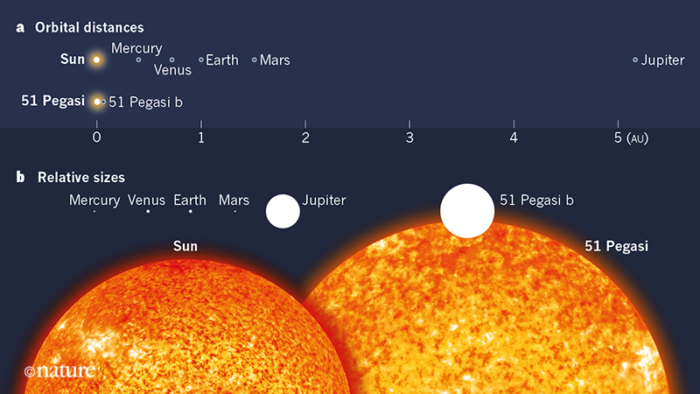Oct 08 2019
2019 Nobel Prize in Physics Goes To Three Astronomers
 It’s Nobel Prize time of year again (it always seems to come around so fast), and the Nobel Prizes for Medicine and Physics have been announced. The physics prize goes to three astronomers, James Peebles, Michel Mayor and Didier Queloz, for contributing to our understanding of the universe and our place in it.
It’s Nobel Prize time of year again (it always seems to come around so fast), and the Nobel Prizes for Medicine and Physics have been announced. The physics prize goes to three astronomers, James Peebles, Michel Mayor and Didier Queloz, for contributing to our understanding of the universe and our place in it.
This is a more abstract Nobel Prize theme than many, and the first awardee, James Peebles, was recognized for a lifetime of collaborative research, more than any specific discovery. I like it.
Peebles was one of the cosmologists who predicted the existence of the cosmic microwave background radiation (CMB). This is the afterglow of the Big Bang at the beginning of our universe. It’s existence was confirmed in 1964 by astronomers Robert Wilson and Arno Penzias. It’s hard to overstate how monumental this prediction and later confirmation were to cosmology and our understanding of the universe.
The utility of the CMB goes beyond confirming the Big Bang. As the name implies, it is now the background temperature or glow of the entire universe. This has proven to be a highly useful window into the history and structure of the universe. Everything on the cosmic scale seems to leave its fingerprints in the CMB. That is always the best kind of discovery, and I have noticed one that attracts the attention of the Nobel committee – discoveries that open up entire fields of subsequent research.
NASA’s COBE (Cosmic Background Explorer) satellite is doing important research into the history and structure of the universe by examining the CMB. For example:
The CMB was found to have intrinsic “anisotropy” for the first time, at a level of a part in 100,000. These tiny variations in the intensity of the CMB over the sky show how matter and energy was distributed when the Universe was still very young. Later, through a process still poorly understood, the early structures seen by DMR developed into galaxies, galaxy clusters, and the large scale structure that we see in the Universe today.
Peebles also co made contributions to the discovery of dark matter and dark energy. Together they comprise 95% of the matter and energy in our universe. Dark matter was first proposed in 1922, but not generally accepted as necessary until around 1980. We still do not know what this matter is made of. Dark energy was discovered in 1998 based upon measurements of the expansion of the universe, which was found to be accelerating.
The other two winners shared the prize for discovering the first exoplanet around a main sequence star – Michel Mayor and Didier Queloz discovered 51 Pegasi b, a gas giant orbiting a star 50 light-years away, in 1995. They made the discovery using the radial velocity method, which looks for regular wobbles in the parent star caused by the gravitational pull of the orbiting planet. This was not the first exoplanet discovered. Previous planets were discovered around pulsars. But this was the first around a main sequence star (like our own sun) opening up the possibility of numerous exoplanets throughout the universe, including ones that potentially could contain life.
This planet, 51 Pegasi b, is what is known as a hot Jupiter – a gas giant orbiting very close to its star, in this case one tenth the distance of Mercury to our sun. Many of the first exoplanets discovered were hot Jupiters, because they have high gravity so the wobble is bigger, and they are close which means they have short periods (less than 10 days). Further, if the transit method is used – dips in brightness due to the planet moving between the star and the Earth, then the dip in light is large because the planet is big. As exoplanets get smaller and farther from their parent star they are more difficult to discover.
This lead to an early bias in exoplanets toward discovering hot Jupiters. However, with many thousands of planets now discovered, we have a better sample size. The current estimate is that about 1.2% of main sequence stars have hot Jupiters around them. This has important consequences for stellar system evolution. Hot Jupiters are thought to form distant from their stars and then migrate in due to gravitational effects. On their way they knock out all the inner rocky planets from the system (you know – the ones most like Earth). They leave a decimated planetary system in their wake. So if you are interested in the prospects for life in the universe, hot Jupiters being relatively uncommon is a good thing.
Mayor and Queloz were recognized by the Nobel committee because of the effect their discovery had on our view of our own place in the universe (tying it with Peebles’ work). I do think that many people (certainly I did) expected that our solar system was typical, and that most of the stars out there had planetary systems somewhat similar to our own. I don’t think the discovery that there were actually lots of exoplanets around other stars was shocking or really changed our view of the universe. But it’s one thing to suspect that is what the universe is like, and another to know as a result of solid scientific evidence.
As always it’s wonderful to have the opportunity to celebrate science and discovery with such a high profile prize.






